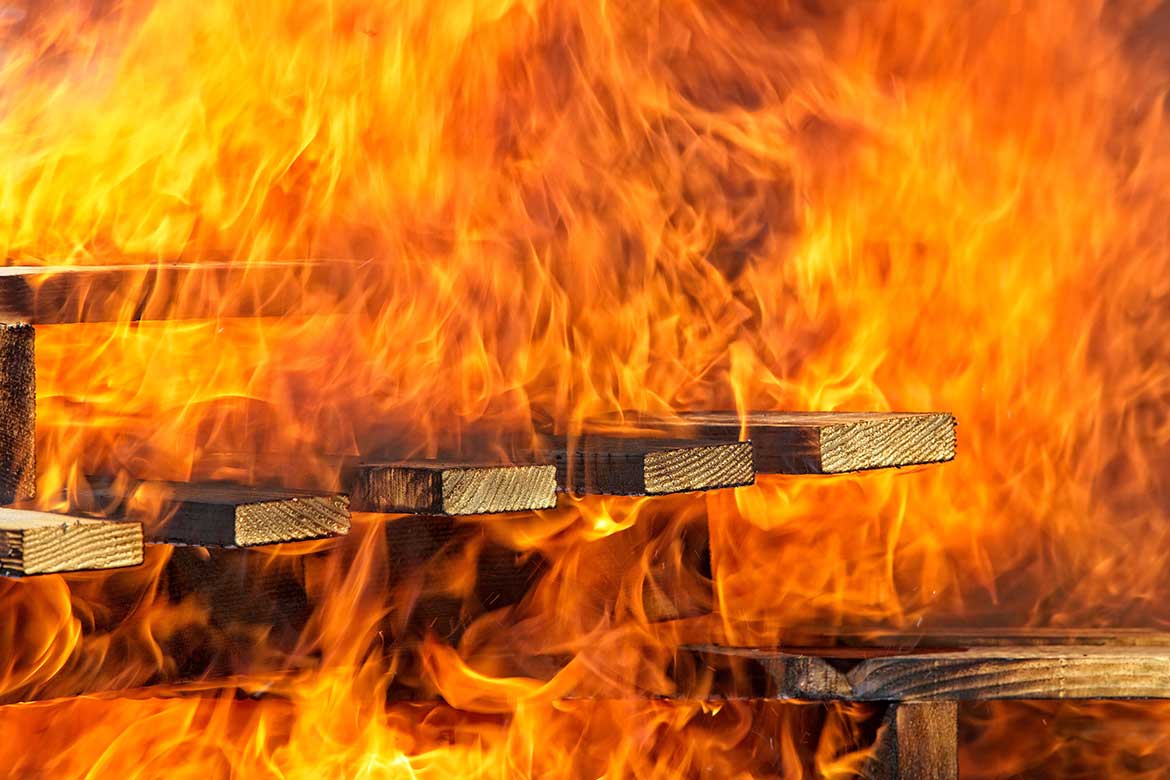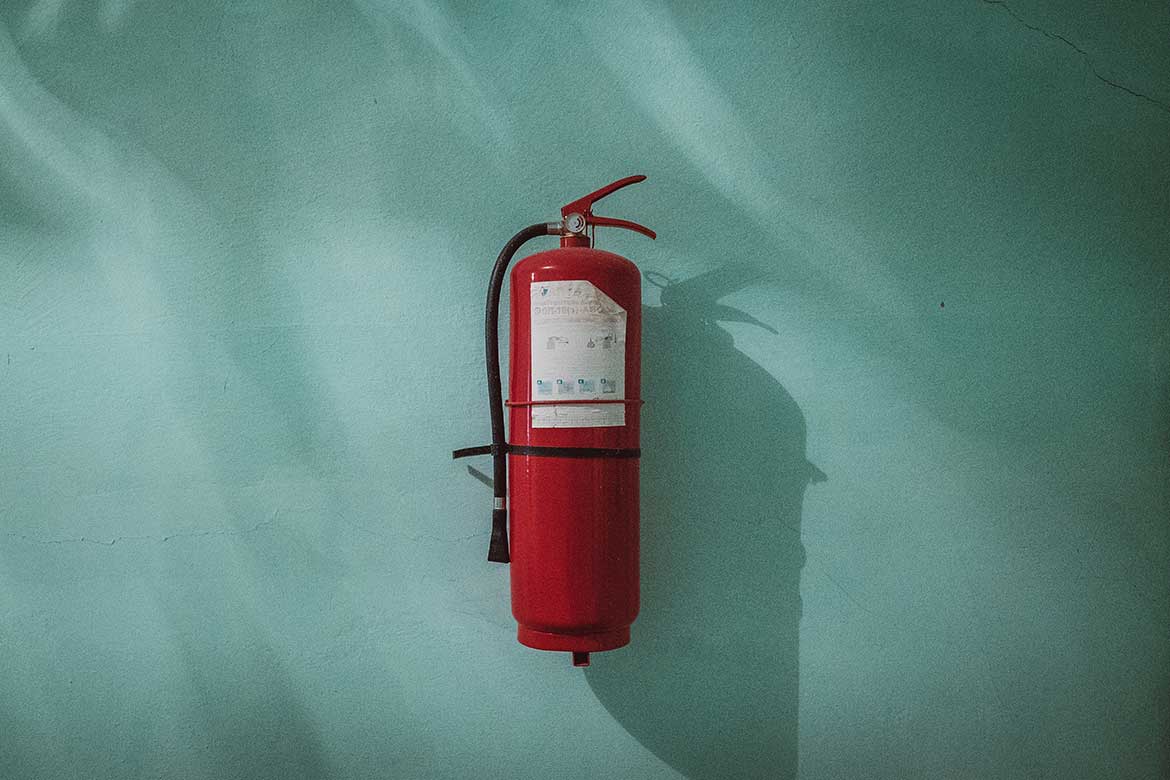9th October, 2025
What Type Of Fire Extinguisher Should You Use On Construction Sites?
On a construction site, like any other workplace, you should always have suitable fire extinguishers readily available and a fire and emergency plan in place. But what type of fire extinguisher should you use on a construction site? Water, foam, powder, carbon dioxide, or wet chemical?

Fire prevention should be a top priority when planning and managing construction work. Why? Because construction sites are at an increased risk of fire. Fire risk factors include unfinished building structures, increased waste, storage of building materials, packaging, storage and use of fuels, and other flammable materials and substances.
These are all fire hazards that must be controlled to prevent a fire from starting on your construction site.
Of course, preventing a fire is always better than dealing with a fire, so get our toolbox talk on construction fire prevention.
But what if a fire does happen on a construction site?
Most workplaces have fixed emergency fire systems in place, like fire alarms, detectors, fire doors, sprinkler systems, etc. These precautions aren't always possible on a construction site, particularly early on in the build. You might not have services installed yet, or doors for that matter!
But you need to have fire safety measures in place on a construction site just as in any other workplace. In fact, due to the increased risks, it's even more important in construction. And one of the most portable types of firefighting equipment is fire extinguishers.

People with the necessary training can safely use fire extinguishers to tackle small fires and prevent them from becoming big fires.
On a construction site, like any other workplace, you should always have suitable fire extinguishers readily to hand and a fire and emergency plan in place. Your fire and emergency procedures should form part of the induction procedure for all site operatives. They should know where fire call points and fire extinguishers are located and understand what to do in the event of a fire.
But what type of fire extinguisher should you use on a construction site?

You need to understand the classes of fire to select suitable fire extinguishers for your site. There are various extinguishers available to tackle different types of fires.
Types of fire:
- Class A (🪵 Solids)
- Class B (🛢️ Liquids)
- Class C (💨 Gases)
- Class D (⛓️ Metals)
- Electrical Fires 🔌
- Class F (🍟 Cooking Fats & Oils)
Any of these types of fires could occur on a construction site, depending on the type of activities that are happening, so you need to have fire extinguishers to deal with the type(s) of fire risk on your site.
Planning your fire arrangements on a construction site can be difficult when compared to other work environments.
In a fixed work environment, it's common to assess the fire risk within a particular location. You can then match the extinguisher to the risk in that specific area.

However, on a construction site, this process is not as straightforward. Construction work is temporary. The risks and hazards within areas change regularly as the construction project progresses. Where you could be installing electrical cables one day, you may be welding or varnishing the next.
Reduce your fire risk with 13 fire prevention tips for construction sites.
Types of fire extinguisher:
- 🧯 Water (A)
- 🧯 Foam (A, B, E*)
- 🧯 Carbon Dioxide (B, E)
- 🧯 Powder (A, B, C, E)
- 🧯 Water Mist (A, B, C, E, F)
- 🧯 Wet Chemical (A, F)
As you can see, there are several types of fire extinguishers available. And there is not one that is right for construction work. You might need a few different types of fire extinguishers to cover the fire risks on your site.
The most common type of fire extinguisher, and the one you are probably most familiar with, is water. And while it can only tackle type A fires (solids), this is also a common fire type.

The most versatile extinguisher type for general construction use, in our opinion, is the dry powder extinguisher. The dry powder extinguisher can tackle most fire types, apart from cooking oils and fats. Dry powder extinguishers can handle wood and waste material fires, and they can also tackle fires involving flammable gases, liquids, and electrical fires.
But it's not a catch-all solution. Dry powder extinguishers are messy, are not suitable for all environments, and should be used with caution in enclosed areas.
Cooking oils and fats are not usually present in large amounts on construction sites. If you do have an on-site canteen and cooking facilities, for example, on big construction sites, you might supply wet chemical extinguishers and fire blankets to that area.
The good news is, you don't have to pick just one type of fire extinguisher for your site. A mixture of extinguisher types will often give you the best protection.

Newer water mist extinguishers (not to be confused with water extinguishers) are also very versatile. They are suitable for all of the same fire types as powder extinguishers (including electrical), plus type F oil and fats. Because they produce a fine mist, water mist fire extinguishers don't conduct electricity. They also don't form puddles of water, which could lead to electrocution.
The way you operate each type of fire extinguisher is slightly different. Some you hold by the nozzle, some you must not.
And safe operation can also depend on the fire type and the environment. It is always necessary to have a sufficient number of operatives on site trained to tackle small fires. Knowing what extinguisher to use, when, and how to use it is essential for safety.
As always, you will need to carry out a fire risk assessment on your site. Each construction site is different and should be assessed on a project-by-project basis.
Your fire risk assessment will help you to identify the hazards and risks that are present throughout the project. You can then decide which types of extinguishers are most suitable for your site, the quantity needed and where to put them. Extinguishers need to be readily available wherever they might need to be accessed.

You may find you need more than one type of fire extinguisher for different areas of your site. For example, if there are mixed fire hazards.
Remember to give your workforce the training and knowledge to identify the different fire types. And to use the firefighting equipment provided.
Using the wrong type of extinguisher on a fire can cause more harm than good. For example, you risk electrocution if you use a water extinguisher on an electrical fire, and you risk suffocation if you use a carbon dioxide extinguisher in a confined space.
Don't forget to keep your fire extinguishers filled and maintained. An empty or faulty extinguisher is of no use in an emergency.
Use the fire extinguisher inspection checklist to carry out a visual inspection of fire extinguishers for your business.
Need help understanding fire extinguishers? Download our free fire extinguisher toolbox talk.
This article was written by Emma at HASpod. Emma has over 10 years experience in health and safety and BSc (Hons) Construction Management. She is NEBOSH qualified and Tech IOSH.
Fire Safety Course
Take our fire safety elearning course and get your certificate today.
Fire Safety CourseRecent posts like this...

What Type Of Fire Extinguisher Should You Use On Construction Sites?
On a construction site, like any other workplace, you should always have suitable fire extinguishers readily available and a fire and emergency plan in place. But what type of fire extinguisher should you use on a construction site? Water, foam, powder, carbon dioxide, or wet chemical?
Read Post
13 Fire Prevention Tips For Construction Sites
Construction sites are at a high risk of fire, so fire prevention must be a top priority when planning and managing construction work. There are a few reasons why a fire could start on your site, but there are ways to make it less likely. Here are 13 tips for fire prevention on construction sites.
Read Post
Who Is Responsible For Completing A Fire Risk Assessment?
Fire risk assessments are a legal requirement for any building that isn't a single private dwelling. But who is responsible for completing the fire risk assessment? In this blog post, we learn about the responsible person under the Regulatory Reform (Fire Safety) Order (RRFSO).
Read Post